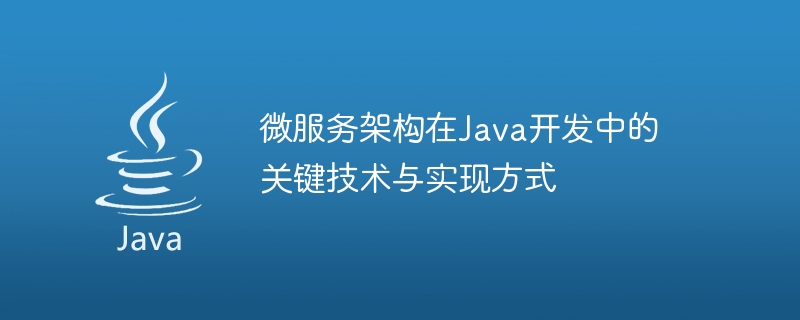Home >Java >javaTutorial >Key technologies and implementation methods of microservice architecture in Java development
Key technologies and implementation methods of microservice architecture in Java development
- PHPzOriginal
- 2023-09-18 09:46:41669browse

Key technologies and implementation methods of microservice architecture in Java development
Introduction:
With the rapid development of the Internet and cloud computing, microservice architecture has become A hot trend in software development. Compared with traditional monolithic architecture, microservice architecture has higher flexibility, scalability and maintainability. This article will introduce the key technologies and implementation methods of microservice architecture in Java development, and provide specific code examples.
1. Service splitting and boundary definition
In the microservice architecture, the original single application is split into multiple independent small services. Services need to be split according to business functions and domain boundaries, and each service should have independent data storage and processing capabilities. At the same time, clearly defined service boundaries can make the dependencies between services clear and facilitate management and maintenance.
Code example:
@Service
public class OrderService {
// ... 省略其他方法
@Autowired
private InventoryService inventoryService;
public void createOrder(Order order) {
// ... 创建订单逻辑
// 调用库存服务进行库存扣减
inventoryService.reduceStock(order.getSkuId(), order.getQuantity());
}
}
@Service
public class InventoryService {
// ... 省略其他方法
public void reduceStock(Long skuId, Integer quantity) {
// ... 扣减库存逻辑
}
} 2. Inter-service communication and API gateway
Communication between services is a core issue in the microservice architecture. Common methods include synchronous HTTP requests and asynchronous message queues. For Java developers, you can use Feign provided by Spring Cloud to simplify the calling of HTTP requests. Additionally, to improve performance and security, API gateways can be used to centrally manage and route all service requests.
Code example:
// 定义库存服务的Feign接口
@FeignClient(name = "inventory-service")
public interface InventoryService {
@RequestMapping(value = "/reduceStock", method = RequestMethod.POST)
void reduceStock(@RequestParam("skuId") Long skuId, @RequestParam("quantity") Integer quantity);
}
// API网关路由配置
@Configuration
public class GatewayConfiguration {
@Bean
public RouteLocator gatewayRoutes(RouteLocatorBuilder builder) {
return builder.routes()
.route("inventory-service", r -> r.path("/inventory/**").uri("lb://inventory-service"))
.build();
}
}3. Service registration and discovery
In the microservice architecture, service registration and discovery are essential. The service instance information is registered to the service registration center through service registration, and the service consumer can obtain the service instance address that needs to be called through the service registration center. Commonly used service registration centers include Zookeeper and Consul. Java developers can use Eureka or Zookeeper provided by Spring Cloud to implement service registration and discovery.
Code example:
# 部分配置省略
eureka:
client:
register-with-eureka: true
fetch-registry: true
service-url:
defaultZone: http://localhost:8761/eureka/4. Fault tolerance and current limiting
In the microservice architecture, calls between services are made through the network, so network failures, service failures and load If it is too high, it may cause the service call to fail. To improve the system's fault tolerance, circuit breakers and current limiting can be used to handle these abnormal conditions. In Java development, the commonly used circuit breaker framework is Hystrix, and the current limiting tool is Resilience4j.
Code sample:
@HystrixCommand(fallbackMethod = "fallbackMethod")
public void reduceStock(Long skuId, Integer quantity) {
// ... 扣减库存逻辑
}5. Distributed transactions
In the microservice architecture, since each service has independent data storage and processing capabilities, it may need to be distributed Processing of transactions. Java developers can use distributed transaction frameworks such as Seata to solve this problem. Seata provides a unified transaction manager, transaction coordinator and transaction participants, which can easily implement distributed transaction processing.
Code sample:
// 开启分布式事务
@GlobalTransactional
public void createOrder(Order order) {
// ... 创建订单逻辑
// 调用库存服务进行库存扣减
inventoryService.reduceStock(order.getSkuId(), order.getQuantity());
// ... 其他逻辑
}Conclusion:
The key technologies of microservice architecture in Java development include service splitting and boundary definition, inter-service communication and API gateway, service registration and discovery , fault tolerance and current limiting, and distributed transactions. By rationally applying these technologies, a highly flexible and scalable microservice architecture can be built to improve the efficiency and quality of software development.
Total word count: 1020 words
The above is the detailed content of Key technologies and implementation methods of microservice architecture in Java development. For more information, please follow other related articles on the PHP Chinese website!

